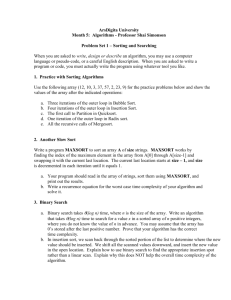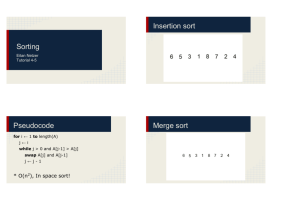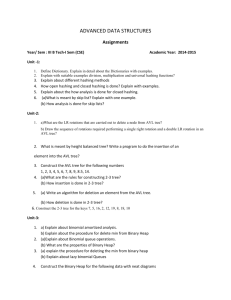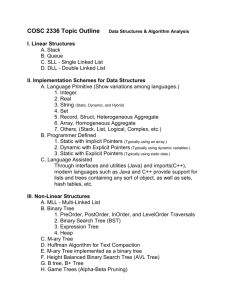Sorting 1
advertisement
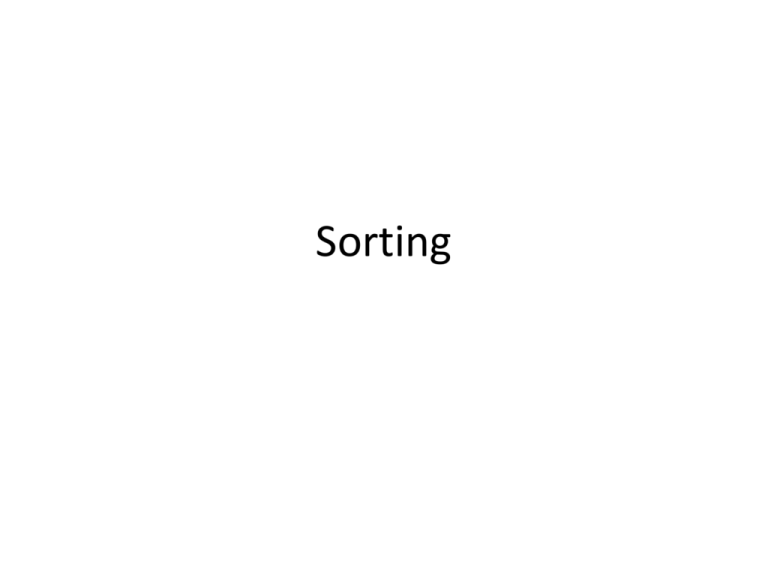
Sorting Pseudocode of Insertion Sort Insertion Sort To sort array A[0..n-1], sort A[0..n-2] recursively and then insert A[n-1] in its proper place among the sorted A[0..n-2] • Usually implemented bottom up (nonrecursively) Example: Sort 6, 4, 1, 8, 5 6|4 1 8 5 4 6|1 8 5 1 4 6|8 5 1 4 6 8|5 1 4 5 6 8 Analysis of Insertion Sort • Time efficiency Cworst(n) = n(n-1)/2 Θ(n2) Cavg(n) ≈ n2/4 Θ(n2) Cbest(n) = n - 1 Θ(n) (also fast on almost sorted arrays) • Space efficiency: in-place • Stability: yes • Best elementary sorting algorithm overall • Binary insertion sort Merge Sort • Divide: Divide the n element array to be sorted in two sub array of n/2 element each. • Conquer: Sort the two sub array recursively using merge sort • Combine: Merge the two sorted sub array to produce the sorted array Mergesort • Split array A[0..n-1] in two about equal halves and make copies of each half in arrays B and C • Sort arrays B and C recursively • Merge sorted arrays B and C into array A as follows: – Repeat the following until no elements remain in one of the arrays: • compare the first elements in the remaining unprocessed portions of the arrays • copy the smaller of the two into A, while incrementing the index indicating the unprocessed portion of that array – Once all elements in one of the arrays are processed, copy the remaining unprocessed elements from the other array into A. Mergesort Example 8 3 2 9 7 1 5 4 8 3 2 9 8 3 8 7 1 5 4 2 9 3 2 3 8 71 9 2 9 7 5 4 1 5 1 7 2 3 8 9 4 5 1 4 5 7 1 2 3 4 5 7 8 9 4 Pseudocode of Mergesort Pseudocode of Merge Analysis of Mergesort • All cases have same efficiency: Θ(n log n) • Number of comparisons in the worst case is close to theoretical minimum for comparisonbased sorting: log2 n! ≈ n log2 n - 1.44n Quick Sort • Divide: The array A[l..r] is partitioned into two nonempty sub array A[l..m] and A[m+1..r] such that each element of A[l..m] is less than or equal to each element of A[m+1..r]. The index m is computed as part of the partitioning process. • Conquer: The two sub array are sorted in place by recursive call to quick sort. • Combine: since the sub arrays are sorted in place, no work is needed to combine them. Quicksort • Select a pivot (partitioning element) – here, the first element • Rearrange the list so that all the elements in the first s positions are smaller than or equal to the pivot and all the elements in the remaining n-s positions are larger than or equal to the pivot p A[i]p A[i]p • Exchange the pivot with the last element in the first (i.e., ) subarray — the pivot is now in its final position • Sort the two subarrays recursively Quicksort Example 5 3 1 9 8 2 4 7 Quick Sort Algorithm Quicksort(A[l..r]) If l< r then m = Partition(A[l..r] Quicksort(A[l..m] Quicksort(A[m+1..l) Partitioning Algorithm • • • • Analysis of Quicksort Best case: split in the middle — Θ(n log n) Worst case: sorted array! — Θ(n2) Average case: random arrays — Θ(n log n) Improvements: – better pivot selection: median of three partitioning – switch to insertion sort on small subfiles – elimination of recursion These combine to 20-25% improvement • Considered the method of choice for internal sorting of large files (n ≥ 10000) Heap and Heap Sort Definition: A heap is a binary tree with the following conditions: • it is essentially complete: all its levels are full, except last level where only some rightmost leaves may be missing • The key at each node is ≥ keys at its children Example 10 10 5 4 7 2 1 a heap 10 5 7 2 1 not a heap 5 6 7 2 1 not a heap Note: Heap’s elements are ordered top down (along any path down from its root), but they are not ordered left to right Some Important Properties of a Heap • Given n, there exists a unique binary tree with n nodes that is essentially complete, with h = log2 n • The root contains the largest key • The subtree rooted at any node of a heap is also a heap • A heap can be represented as an array Heap’s Array Representation Store heap’s elements in an array (whose elements indexed, for convenience, 1 to n) in top-down left-to-right order Example: 9 1 2 3 4 5 6 5 1 • • • • 3 4 9 5 3 1 4 2 2 Left child of node j is at 2j Right child of node j is at 2j+1 Parent of node j is at j/2 Parental nodes are represented in the first n/2 locations Heap Construction (bottom-up) Step 0: Initialize the structure with keys in the order given Step 1: Starting with the last (rightmost) parental node, fix the heap rooted at it, if it doesn’t satisfy the heap condition: keep exchanging it with its largest child until the heap condition holds Step 2: Repeat Step 1 for the preceding parental node Example of Heap Construction Construct a heap for the list 2, 9, 7, 6, 5, 8 2 2 9 6 7 5 > 9 6 8 8 5 2 8 5 7 9 8 6 5 7 9 9 6 2 7 > 9 2 6 8 5 7 > 6 2 8 5 7 Bottom-up heap construction algorithm Heap sort Algorithm: 1. Build heap 2. Remove root –exchange with last (rightmost) leaf 3. Fix up heap (excluding last leaf) Repeat 2, 3 until heap contains just one node. Root deletion The root of a heap can be deleted and the heap fixed up as follows: • exchange the root with the last leaf • compare the new root (formerly the leaf) with each of its children and, if one of them is larger than the root, exchange it with the larger of the two. • continue the comparison/exchange with the children of the new root until it reaches a level of the tree where it is larger than both its children Example of Sorting by Heapsort Sort the list 2, 9, 7, 6, 5, 8 by heapsort Stage 1 (heap construction) 2 9 7 6 5 8 2 9 8 6 5 7 2 9 8 6 5 7 9 2 8 6 5 7 9 6 8 2 5 7 Stage 2 (root/max removal) 9 6 8 2 5 7 7 6 8 2 5|9 8 6 7 2 5|9 5 6 7 2|8 9 7 6 5 2|8 9 2 6 5|7 8 9 6 2 5|7 8 9 5 2|6 7 8 9 5 2|6 7 8 9 2|5 6 7 8 9 Analysis of Heap sort (continued) Recall algorithm: 1. Build heap Θ(n) 2. Remove root –exchange with last (rightmost) leaf Θ(log n) 3. Fix up heap (excluding last leaf) n – 1 times Repeat 2, 3 until heap contains just one node. Total: Θ(n) + Θ( n log n) = Θ(n log n) • Note: this is the worst case. Average case also Θ(n log n). Priority queues • A priority queue is the ADT of an ordered set with the operations: – find element with highest priority – delete element with highest priority – insert element with assigned priority • Heaps are very good for implementing priority queues Insertion of a new element • Insert element at last position in heap. • Compare with its parent and if it violates heap condition exchange them • Continue comparing the new element with nodes up the tree until the heap condition is satisfied Insertion of a New Element into a Heap • Insert the new element at last position in heap. • Compare it with its parent and, if it violates heap condition, exchange them • Continue comparing the new element with nodes up the tree until the heap condition is satisfied Example: Insert key 10 9 6 2 > 8 5 10 9 7 10 Efficiency: O(log n) 6 2 > 10 5 7 8 2 6 9 5 7 8 Bottom-up vs. Top-down heap construction • Top down: Heaps can be constructed by successively inserting elements into an (initially) empty heap • Bottom-up: Put everything in and then fix it Radix Sort • Based on examining digits in some base-b numeric representation of items (or keys) • Least significant digit radix sort – Processes digits from right to left – Used in early punched-card sorting machines • Create groupings of items with same value in specified digit – Collect in order and create grouping with next significant digit 33 Radix Sort • Sort each digit (or field) separately. • Start with the least-significant digit. • Radix sort must invoke a stable sort. RADIX-SORT(A, d) 1 for i ← 1 to d 2 do use a stable sort to sort array A on digit i 34 Running Time of Radix Sort • use counting sort as the invoked stable sort, if the range of digits is not large • if digit range is 1..k, then each pass takes Θ(n+k) time • there are d passes, for a total of Θ(d(n+k)) • if k = O(n), time is Θ(dn) • when d is const, we have Θ(n), linear! 35 Another example • • • • • • • • • • • • • • Radix Sort Example data[ ] 123 234 345 456 543 987 654 23 76 934 765 452 857 356 805 294 490 780 120 200 73 Buckets[ ] 0: 490 780 120 200 1: 2: 452 3: 123 543 23 73 4: 234 654 934 294 5: 345 765 805 6: 456 76 356 7: 987 857 8: 9: Another example (Cont.) • data[ ] • 490 780 120 200 452 123 543 23 73 234 654 934 294 345 765 805 456 76 356 987 857 • Buckets[ ] • 0: 200 805 • 1: • 2: 120 123 23 • 3: 234 934 • 4: 345 543 • 5: 452 654 456 356 857 • 6: 765 • 7: 73 76 • 8: 780 987 • 9: 490 294 Another example (Cont.) • • • • • • • • • • • • • • • data[ ] 200 805 120 123 23 234 934 345 543 452 654 456 356 857 765 73 76 780 987 490 294 buckets[ ] 0: 23 73 76 1: 120 123 2: 200 234 294 3: 345 356 4: 452 456 490 5: 543 6: 654 7: 765 780 8: 805 857 9: 934 987 data[ ] 23 73 76 120 123 200 234 294 345 356 452 456 490 543 654 765 780 805 857 934 987
